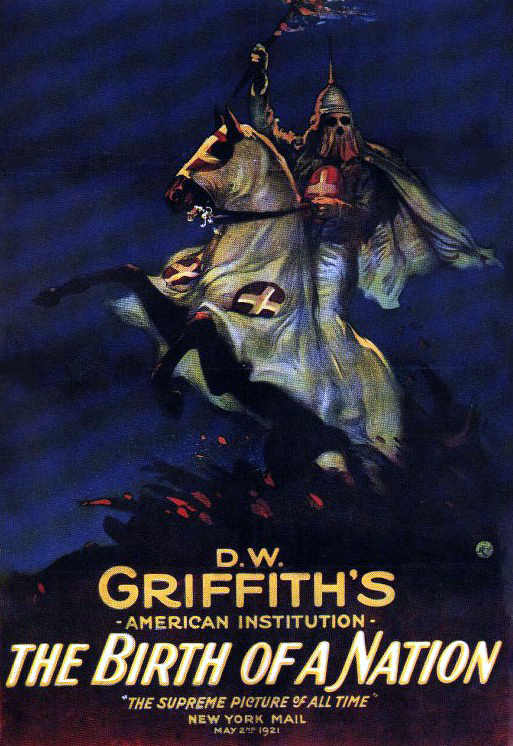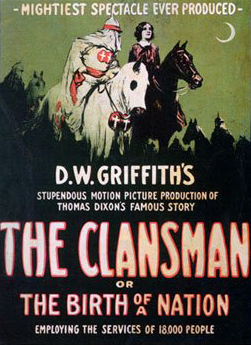
There are two kinds, or degrees, of racism in The Birth Of A Nation. The first might be described as environmental racism, reflecting the conventional racism of the dominant culture of early 20th-Century America. This centered on the idea that blacks were intellectually inferior to whites, unfitted for social or political equality, and best treated with a kind of benign paternalism.
In 1915 one might hold such views almost unconsciously, so imbedded were they in the thinking of the time, and one might find “scientific” explanations for the inferiority of blacks even in the pages of authoritative reference works like the Encyclopedia Britannica.
Other viewpoints were available, however — other public voices which insisted that blacks were fully the equals of whites and deserved to participate fully in American democracy and American society. The attitude of the dominant culture did not go unchallenged, and so involved a measure of choice, of moral responsibility. Moreover, the dominant culture benefited psychologically and financially from maintaining blacks as a permanent underclass and source of cheap labor, so its view of their inherent inferiority incorporated an element of self-serving denial.
In short, there was very little about environmental racism which could be considered morally neutral or benign, even though it could be entertained by people who were in other respects decent and good-hearted.
The second kind of racism in The Birth Of A Nation has a darker undertone. While it derives from the assumptions of environmental racism it moves into a frankly pathological realm. It held that blacks were not just intellectually inferior but animalistic, distinctly subhuman, and would, if ungoverned by strict regimentation on the part of whites,
revert to bestial behavior, especially with regard to sexuality, and particularly with regard to sexual aggression by black males against white females.
The social history of race relations in America provided almost no evidence to support this view — quite the contrary. Historically speaking, sexual aggression and sexual abuse between the races resided almost exclusively in the sexual predation of white males directed against black females within the Southern plantation system. This was the unspoken scandal of ante-bellum society in the South, as Mary Chestnut confessed ruefully in the original unexpurgated version of her famous diary.
The fictive threat to white womanhood from black males had origins within the psyches of white males — under threat in 1915 from social causes inherent in a rapidly industrializing and urbanizing America. Males increasingly worked for and at the pleasure of other men far more powerful than themselves, and women had access to incomes from office and factory work independent of male domestic partners.
The male insecurity that resulted was augmented by cultural insecurity as waves of immigrants began to change the face of America, importing “foreign” mores, customs, values and even languages that competed with those of the dominant culture.
In this atmosphere, the casual environmental racism of the dominant white culture took a more intense and programmatic form — it mutated into a defiant celebration of the “Aryan race”, an aggressive insistence on its superiority, and an essentially pathological fear of its dilution, or even overthrow, by lesser races, especially the animalistic “Negro” race.

The great success of Thomas Dixon’s potboiler fiction, which openly promoted this new, more self-conscious and aggressive racism, testifies to its wide cultural appeal at the beginning of the 20th Century. In his skewed and irresponsibly manipulated version of the historical facts of Reconstruction, Dixon was presenting a prophecy of what might happen to white culture if “lesser” races ever again got the upper hand. He was quite clear about this. His introduction to The Clansman, the novel on which The Birth Of A Nation was partly based and under which title it was originally released, described Reconstruction as one of the most important episodes, not in the history of America, but in the history of the Aryan race.
Thinking of the history of America as the history of the triumph of the Aryan race was appealing to many in early 20th-Century America — it bolstered the manhood of white males threatened by new female power and new cultural influences. It was psychologically seductive.
One of the men it seduced was D. W. Griffith. It was an ironic tragedy, since Griffith was himself, by all accounts, a benign sort of racist in his dealings with individual blacks, and also a man deeply sympathetic, in his way and within his limitations, to the emerging
position of the “modern woman”. One can only conclude that the seduction took place on some level beneath the conscious — as it must have, surely, to some degree, for American society as a whole.
I’m not sure the process can ever be wholly understood, but from a distance it can at least be described, and I think there’s some value in that. In future posts I’ll offer some examples of how the two kinds of racism described above play out in The Birth Of A Nation.
